Castello Aragonese is one of the best things to do in Ischia and for good reason – castles don’t get much more dramatic than this medieval fortress on a rocky island. If you’re planning to go to Ischia and visit Castello Aragonese, here’s everything you need to know to make the most of your trip – and even find out how to stay overnight at this spectacular castle in Ischia!
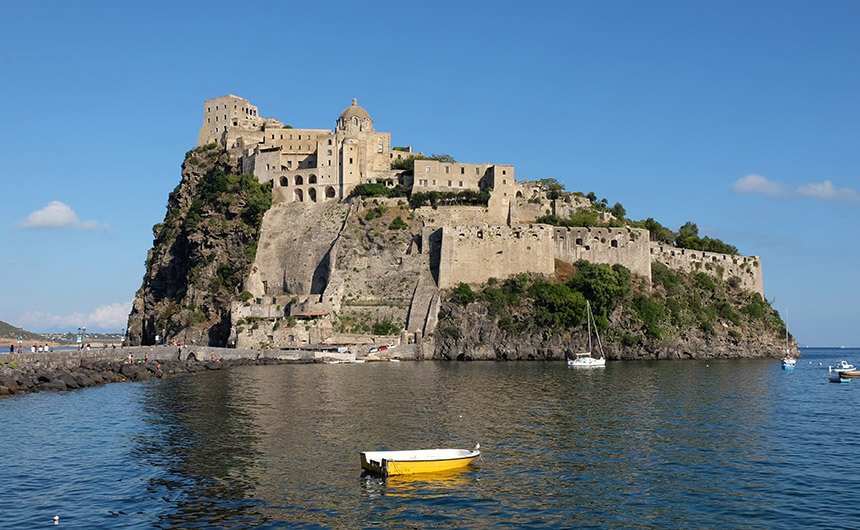
The history of Castello Aragonese
What you see at Castello Aragonese today is the result of hundreds of years of volcanic eruptions, battles and power struggles.
5th century BC: Gerone of Syracuse established the first settlement on the rock. It was originally named Castrum Gironis and was connected to the main island.
4th century BC: The Romans founded a city called Aenaria at the foot of the rock. They probably also used the earlier defensive walls.
2nd century AD: A volcanic eruption destroyed Aenaria and cut the rock off from the main island.
Middle ages: During medieval times Ischia was called Insula Major, so the Ischia castle rock was called Insula Minor to distinguish it from its much larger neighbour. During this time there was a series of raids and invasions.
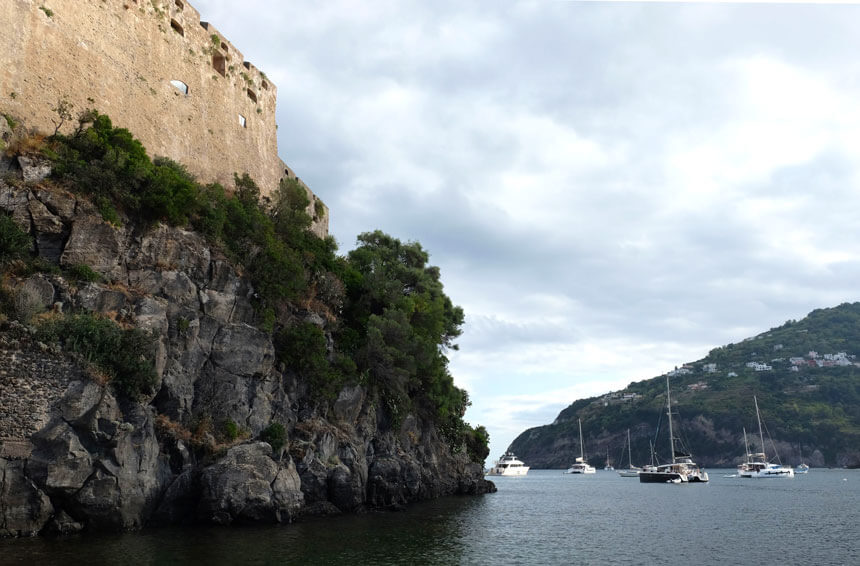
12th century: Ischia was ruled by the Normans, but not for long. In 1194 Henry IV of Swabia, the Holy Roman Emperor, King of Italy and King of Germany conquered the island. The castle became home to noble families for the first time.
13th century: There are struggles between the Swabians, Angevins and the Aragonese. The Angevins achieved a definitive victory in 1299 and built the first bridge connecting the castle and the main island of Ischia (then still called Insular Major).
14th century: Another volcanic eruption destroyed much of the area around modern Ischia Porto and Ischia Ponte. The islanders took refuge on the castle rock and added facilities (including the Cathedral of the Assumption) that turned the fortress into a real town.
15th century: Alfonso I of Aragon built up the castle walls and excavated a tunnel inside the rock to allow pedestrian access up inside the rock. From this point on it was known by its modern name, Castello Aragonese (Aragonese Castle).
17th century: In 1637 there were only 250 inhabitants as islanders left to find land to cultivate elsewhere on Ischia. There was a convent on the island at this point.
18th century: Most of the castle was abandoned, leaving only the fortress, the cathedral, the convent and the prison operational.
19th century: The castle suffered enormous damage during clashes between Anglo-Bourbon and French forces. The nuns were forced to leave and the ruined castle was used as a prison. In 1860 Ischia became part of the newly-unified Kingdom of Italy and the castle passed to the state.
1912: The Castello Aragonese was sold at auction to a private buyer. Throughout the 20th century a series of owners restored and renovated the castle. It opened to the public in the 1990s.
What is there to see at Castello Aragonese?
Your visit to Castello Aragonese will start with a walk down a long tunnel from the ticket office to a lift that’ll take you straight up through the rock – a fantastic surprise if you were expecting to climb up to the castle buildings.
At the top of the lift you’ll start a 2km walking tour which will take you to all the key sights at the castle. I really liked this approach as, although you can’t wander wherever you want, you can be certain that you won’t miss anything important. It’s best to wear comfortable shoes and take some water with you.
There are 25 stops on the tour, and you will get to see them all, but there are some real highlights.
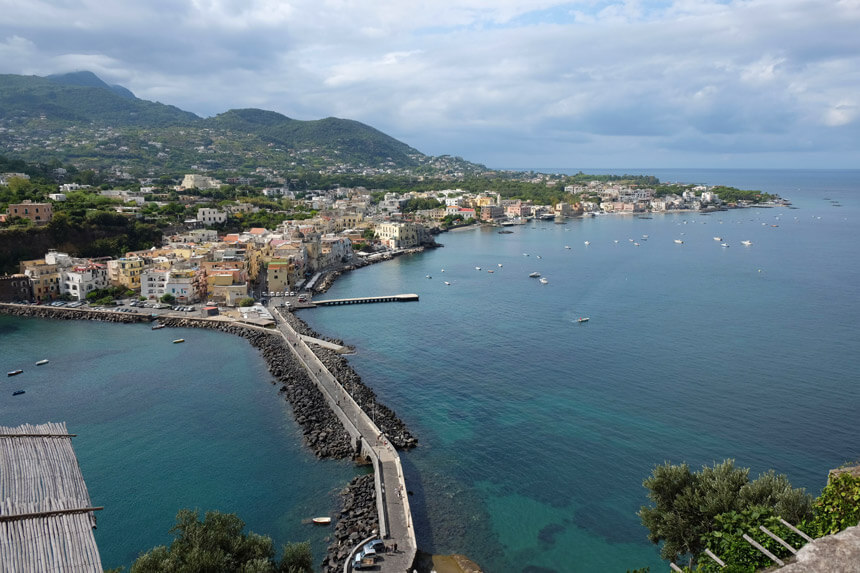
Terrace of the Immaculate Conception
The first stop on the tour gives you your first sight of Castello Aragonese’s real money shot – a view across the bridge, Ischia Ponte, Spiaggia dei Pescatori (Fisherman’s Beach) and Monte Epomeo in the background. This is the picture that first made me want to visit Ischia – it’s every bit as gorgeous in the flesh.
Church of the Immaculate Conception
Leading off the Terrace of the Immaculate Conception, this church was built sometime after 1737 and was commissioned by the Convent of the Poor Clares (more of them in a minute). They ran out of money before the church was finished and had to sell the Convent’s silverware to get it somewhat complete. It’s very stark, white and unadorned inside, which makes it perfect for its modern-day role as an art gallery.
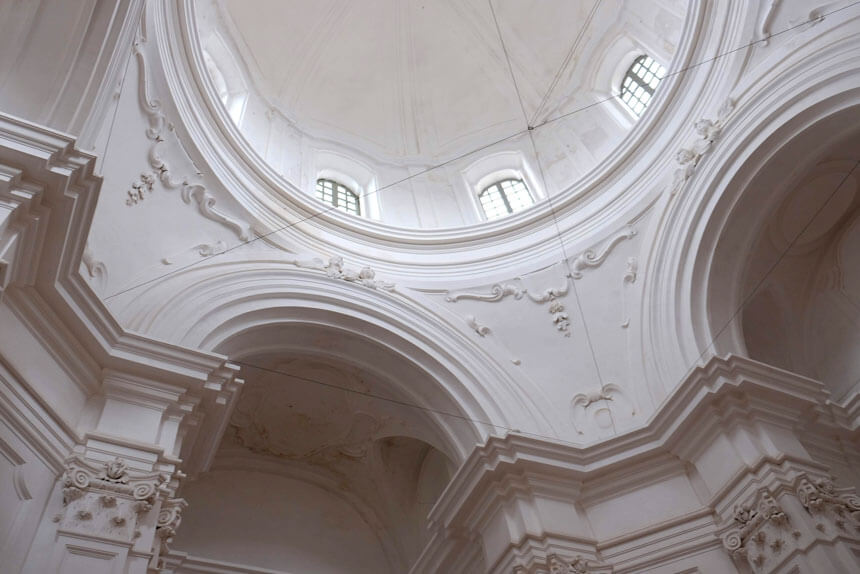
Convent Cloister
This pretty part of the castle used to be the entrance hall and cloister for the Convent of St Mary of Consolation. Between 1575 and 1810 this was where nuns from the Order of the Poor Clares lived on the island. They were mostly the first-born daughters from noble families who went into the convent largely to make sure that the family wealth would be inherited by the first male child.
The Nuns’ Cemetery
The modern-day Castello Aragonese is so beautiful that you might not be expecting this part of the tour. Or, like me, you might be a bit ghoulishly fascinated by this part of the castle’s story.
The Order of the Poor Clares were somewhat obsessed with death. They believed that the body was a useless container for the spirit, and that, once you were dead, the body shouldn’t be paid any special attention, for example by being buried.
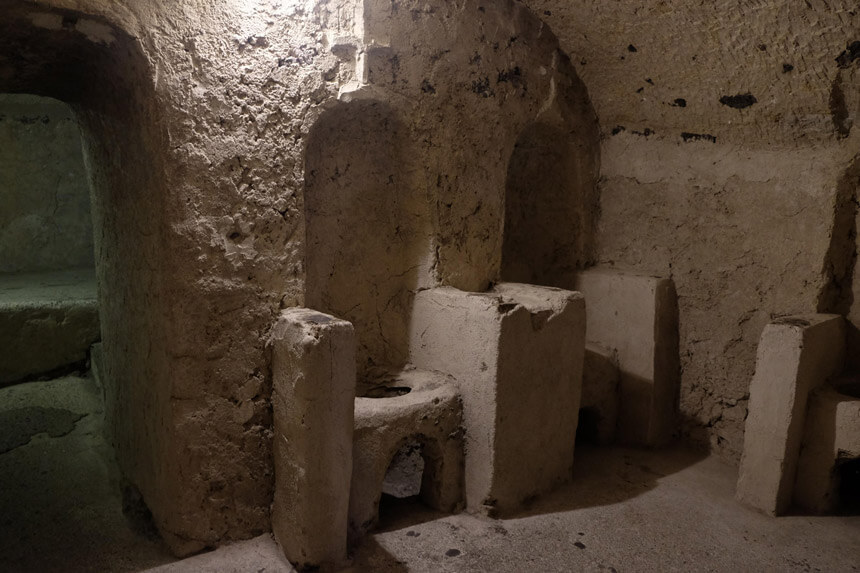
Instead of being buried, the dead nuns’ bodies were placed on stone chairs in the cemetery underneath the Church of the Immaculate Conception. The chairs had a hole in the seat, and a bowl underneath to catch the fluid as the body slowly decomposed. Once the flesh had entirely gone, the bones would be piled up in the ossuary and the chair would get a new occupant.
The living nuns used to spend hours each day meditating on death in the cemetery, surrounded by the decomposing corpses of their former sisters. This wasn’t the healthiest of habits and many of the nuns contracted serious diseases – often bad enough to put them into the cemetery for an unexpectedly extended stay.
When you get out from the seriously creepy cemetery you’ll probably want a bit of air – luckily the Convent Viewpoint next to the cemetery entrance is on hand with that stunning view over Ischia Ponte.
Church of St Peter at Pantaniello
This is the prettiest building at Castello Aragonese; a 6-sided chapel with beautiful arched windows and views over the gardens and the sea. It dates back to 1564 and the windows were originally entrances to five chapels around the edge of the central space. Today the central space is all that remains, along with those views.
Sitting dreamily in one of the windows at this beautiful castle in Ischia is a much sought-after photo op, so expect to have a bit of a wait to get your perfect Instagram moment.
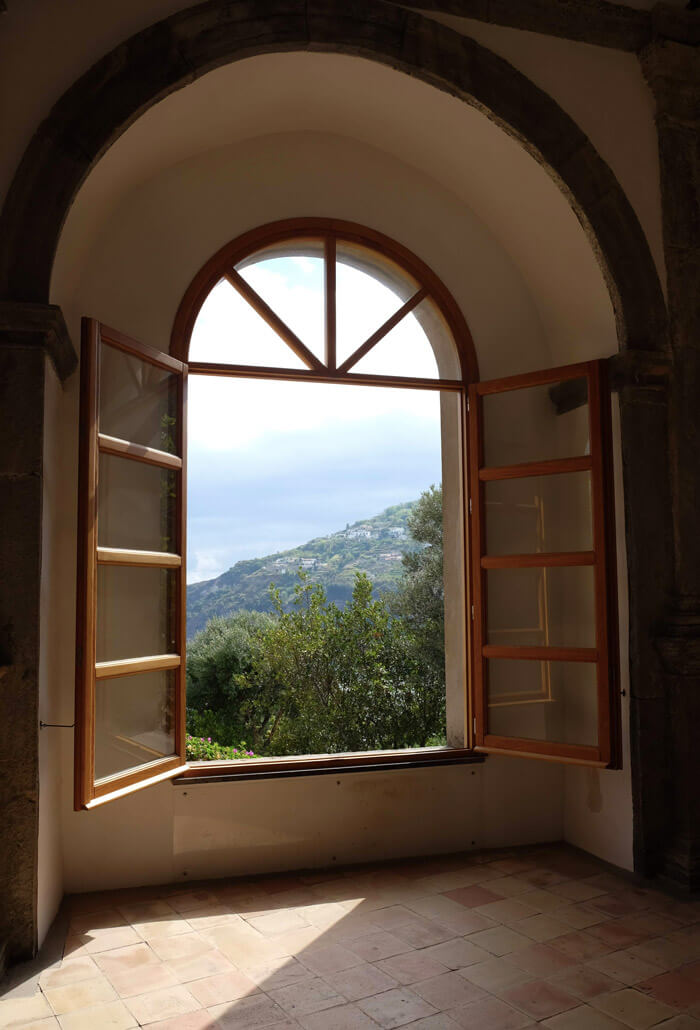
The Bourbon Prison
In 1823 the powerful Bourbons of Naples turned this building into a prison, and from 1851 political prisoners were held here alongside criminals. It’s a large, forbidding and atmospheric part of the castle.
Terrace of Olive Trees
This terrace was once the castle’s garden and looks out to sea, with a view of Ischia’s neighbouring island Procida. Steps up from here lead to “Il Terrazzo” cafe, the highest point that you can visit at Castello Aragonese.
The gardens
I’ve grouped several stops on the tour into this section, because in all honesty they do sort of roll into one. That’s not a bad thing though, as they’re all beautiful and are dotted with little churches and look-out points.
From the Terrace of Olive Trees you’ll start making your way down through gardens filled with gorgeous flowers, cacti and with views either out to sea, across to Procida or towards Ischia Ponte. The owners of the castle call this the Sun Route, and it’s truly enchanting.
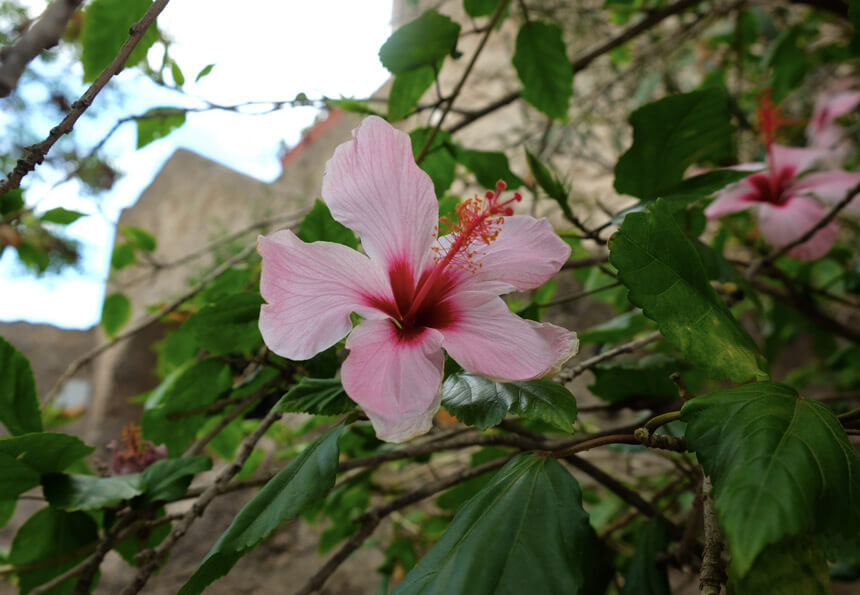
Near the end of the tour you’ll get to the Cathedral of Our Lady of the Assumption (you can also visit the crypt), then there’s one final viewpoint before you take the lift back down to the castle entrance. Make sure you make the most of the view!
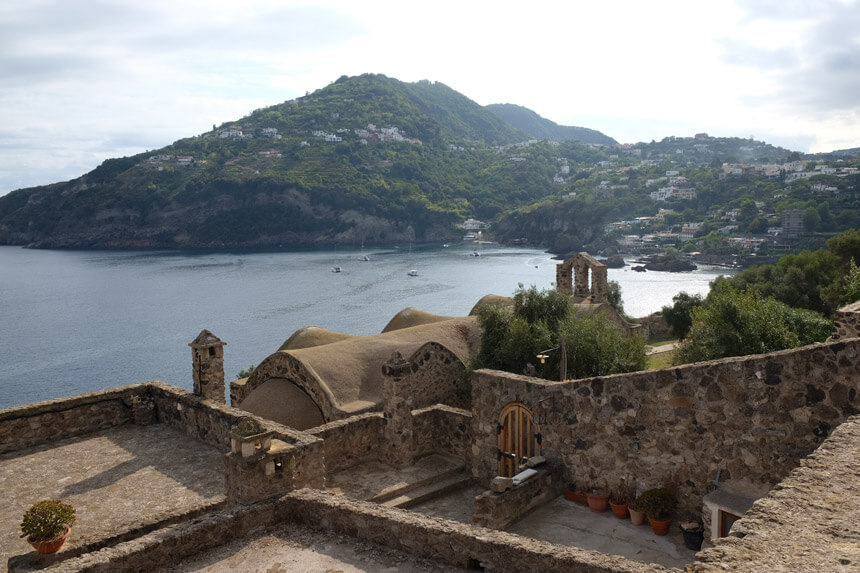
How long does a visit to the castle take?
Walking the tour route will take at least 1.5 hours, but when I visited we spent around 3 hours at the castle. The views from the castle walls are breathtaking and you’ll want to spend some time drinking them in. You might also want to stop for a drink and something to eat at one of the restaurants.
Guided tours of Castello Aragonese
The official website suggests that guided tours of the castle are available but we weren’t offered one and I didn’t see anyone else taking a tour. If you’re keen to take a guided tour I’d recommend contacting the castle owners to see what’s available.
The signage around the castle complex is relatively good and the defined route means you’re unlikely to miss out on anything.
How to get to Castello Aragonese
Getting to Castello Aragonese is really easy. If you’re staying in Ischia Ponte it’s impossible to miss as the causeway bridge to the castle is in the middle of Ischia Ponte town – in fact it’s what gives the village its name as Ponte is Italian for bridge.
If you’re staying either in Ischia Porto or between Porto and Ponte, then the walk to the castle is an easy amble either along Corso Vittoria Colonna which is lined with shops, restaurants and gelato stands, or via Lungomare Cristoforo Colombo and Spiaggia dei Pescatori (Fisherman’s Beach)
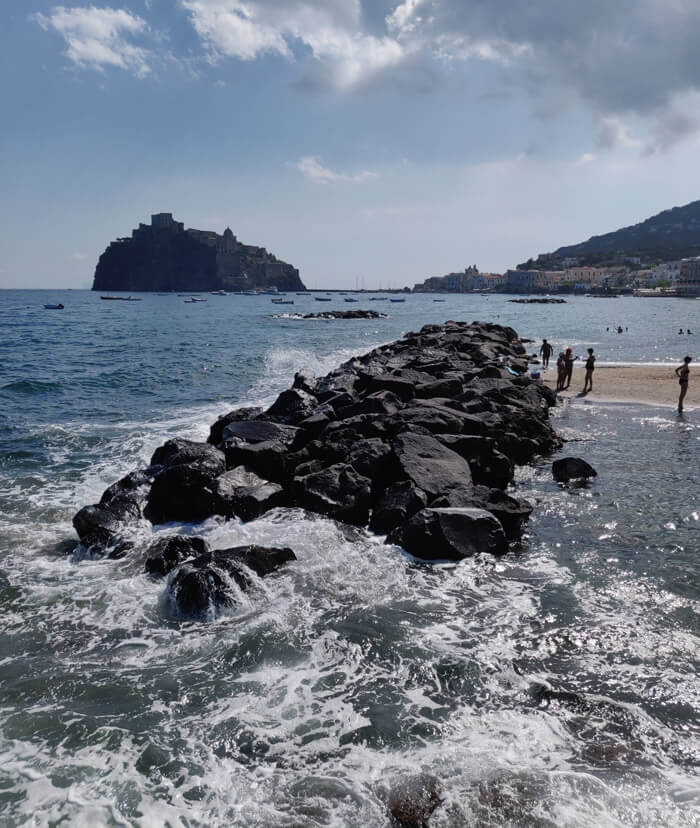
If you’re staying elsewhere on Ischia or you’d prefer not to walk from Ischia Porto, then the number 7 bus runs from the island’s main bus station behind the port. It connects with the CS, CD, 1 and 2 buses so if you’re travelling from other towns like Forio, Casamiccola Terme or Sant’Angelo you can do the whole trip by bus. The number 7 bus is more of a minibus and drops you off right at the end of the bridge.
Taxis are also available across the island (although they are quite expensive in Ischia). If you’ve rented a car or scooter for your trip to Ischia then there’s a car park in Ischia Ponte just to the right of the bridge, behind the harbour wall.
Visiting Castello Aragonese as a day trip from Naples
It’s easy to visit Castello Aragonese from Naples. First you’ll need to take a ferry from Naples to Ischia Porto. From Ischia Porto you can then either walk to Ischia Ponte (3km – around 45 minutes and a very pleasant walk) or catch the number 7 bus from the bus station behind the port.
Buying Castello Aragonese tickets
Tickets to visit Castello Aragonese cost €12 for adults and €6 for children aged 10-18. Under 10s get in free. You can buy your tickets at the ticket office at the entrance, straight after going through the arch at the end of the bridge.
Make sure you have cash to buy your tickets. They’ve been claiming that card payments are coming soon for the last two years but when I visited in September 2019 it was definitely cash only. If you’ve visited more recently and they are accepting cards (hurrah!) please do let me know in the comments.
There are ATMs in Ischia Ponte, although all the ones I saw were the scammy type with massive fees that I always try to avoid on holiday.
You don’t need to book in advance to visit the castle. At busy times you may need to queue to take the lift from the castle entrance up to the top; it’s very small and doesn’t carry very many people at once.
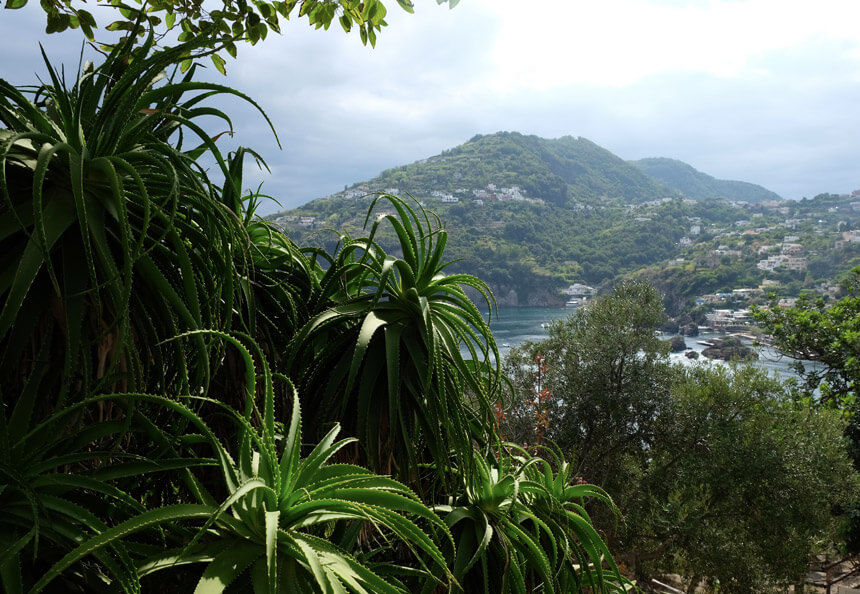
Opening hours
Most parts of Castello Aragonese are open 7 days a week from 9am to sunset, although please check the castle website for the latest information. The restaurants, gallery and bookshop may have different opening times.
Eating and drinking at the castle
There are two cafe restaurants inside the castle – one in a garden setting near the Church of the Immaculate Conception and another at the highest publicly-accessible point of the castle. This one has far-reaching views across the Bay of Naples.
Both cafes are rather pricey for both food and drink so you might prefer to eat in Ischia Ponte. There are lots of cafes, restaurants and bars at the other end of the bridge, many with lovely views of the castle.
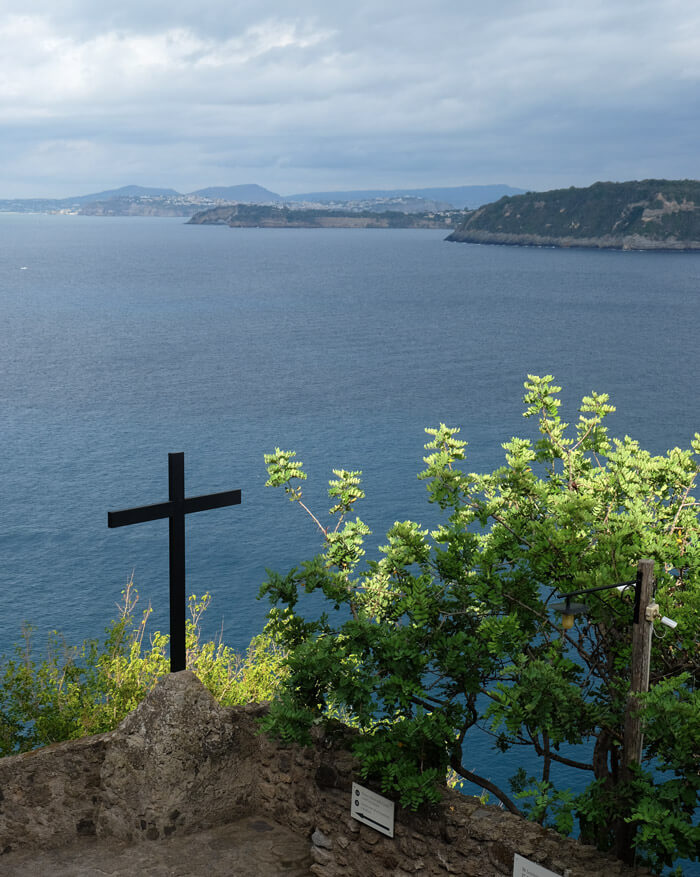
Can you stay overnight at Castello Aragonese?
Yes you can! There’s a hotel inside Castello Aragonese, and it’s one of the most incredible places to stay in Ischia. Albergo Il Monastero is a 3 star hotel, fairly simply furnished so not quite the opulent experience that you might expect from a hotel in a castle. All the rooms are set in the historic buildings though with lots of original features so the simple furnishings really let the history shine. Many of the rooms have sea views or views over Ischia Ponte, and the photos of the views at sunset look incredible.
There’s a restaurant for guests, supplied by the castle’s own vegetable garden. If you book the hotel’s Altana suite you can have your dinner served on your private terrace by candlelight – dreamy!
Check out photos and reviews of Castello Aragonese’s hotel on Booking.com.
Related posts
If you enjoyed this post, you might find my other posts about Ischia and the bay of Naples useful:
- The best things to do in Ischia
- Where to stay in Ischia – the best villages, beaches and hotels for every type of trip
- How to get from Naples to Ischia by ferry
- Visiting Ischia’s best thermal spa, Negombo
- How to visit Giardini la Mortella, a garden love story on Ischia
- Tips for visiting Procida, a tiny, colourful island near Ischia
- 12 tips for visiting the ancient Roman city Pompeii (plus how to climb Vesuvius)
- The best places to stay to visit Pompeii
- Advice for visiting Herculaneum, the “other Pompeii”
- The best day trips from Sorrento
Would you like to visit Castello Aragonese in Ischia? Pin it for later!
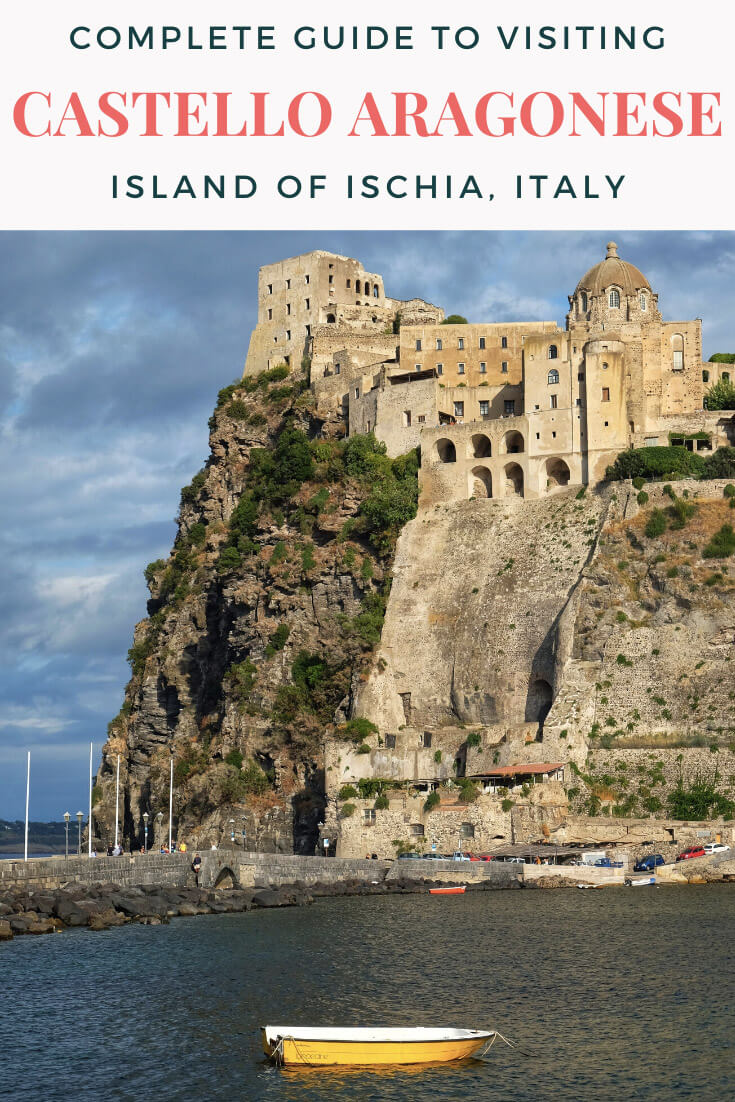


I’ll update this very good article since somethings have changed. The castle is open only 4 days a week now, Monday, Wednesday, Friday and Saturday from 9 am to 8:30 pm the last ticket issued at 7 pm. The elevator up is not open, the walk up is worth it since it’s carved mostly out of the mountain and you can almost imagine boiling water being poured through the murder hole in the ceiling. Speaking of which, the article completely ignores the small but really cool exhibit rooms (again, carved out of the mountain) with medieval armor, weapons and torture devices. Possibly because if you take the elevator up and down you’ll never pass the exhibits. All the restaurants and cafes have diminished seating but the Il Monastero restaurant is now open 7 days a week. Evening reservations at Il Monastero come with a ride up the elevator. Dining at Il Monastero alone is worth a trip to Ischia, as the restaurant hosts one of the finest chefs and wait staffs in all of Ischia if not Italy, and the view is exceptionally romantic and dramatic especially when dining on the outside terrace. Mistakenly the article says the restaurant is for guests of the hotel only, but this is not true, however tables especially now, may be limited so book early. And finally the article does not mention that you can certainly picnic at the Terrace Olive Garden, peaceful and shady, with a view out over the Bay of Naples and the Italian coast line with Vesuvius looming in the distance, this would be nearly the same view Pliny would have had when viewing the eruption of 79 A.D. Pack a lunch cause there is no finer place for a picnic.
Stayed with a friend’s relatives for 8 days on the island. It was a fabulous experience. I love Ischia